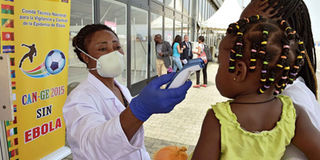Ebola is still flaring up in some areas, warns United Nations

A medical worker checks the temperature of a young girl at an Ebola screening centre at Bata airport in Bata, Equatorial Guinea, on January 15, 2015. PHOTO | CARL DE SOUZA | AFP
What you need to know:
- The worst outbreak of the virus in history has seen nearly 9,000 deaths in a year, mainly in Liberia, Guinea and Sierra Leone.
- The three nations have been devastated by the outbreak but all have seen recent signs that the virus is on the wane, with the number of new cases dropping weekly.
- Only 99 new cases were confirmed in the week up to January 25, the first time the figure has dropped below 100 since June 2014, according to WHO.
- Liberia, once the country worst hit by the outbreak, hopes to have no new cases by the end of next month.
ADDIS ABABA
The Ebola epidemic is decreasing but is still present in a third of the areas of the three worst affected west African nations, UN Ebola coordinator David Nabarro warned on Thursday.
“The number of cases is decreasing week by week and getting to zero in many places... but we still see occasional flare-ups and we still see some surprises with new cases out of our contact lists,” Mr Nabarro told AFP.
“That means that the epidemic is not contained yet,” he said.
He was speaking at the African Union headquarters, as leaders gather a day ahead of a summit meeting where Ebola is a key issue for discussion.
The worst outbreak of the virus in history has seen nearly 9,000 deaths in a year — almost all in the three west African countries of Liberia, Guinea and Sierra Leone — and sparked a major health scare worldwide.
RECENT SIGNS
The three nations have been devastated by the outbreak, which began in December 2013, but all have seen recent signs that the virus is on the wane, with the number of new cases dropping weekly.
Only 99 new cases were confirmed in the week up to January 25, the first time the figure has dropped below 100 since June 2014, the World Health Organisation said on Thursday in Geneva.
“The response.... has now moved to a second phase, as the focus shifts from slowing transmission to ending the epidemic,” the WHO said in a statement.
“To achieve this goal as quickly as possible, efforts have moved from rapidly building infrastructure to ensuring that capacity for case finding, case management, safe burials, and community engagement is used as effectively as possible.”
Liberia, once the country worst hit by the outbreak, hopes to have no new cases by the end of next month.
“We must maintain the effort with even greater intensity, the forthcoming rainy season is a concern,” Mr Nabarro said.
But he also said there were key lessons from the response to Ebola, and said that a proposal to set up an African equivalent to the United States’ Centers for Disease Control and Prevention (CDC) would be a step forward.
TOOK TOO LONG
“I took us too long to be ready, we need a better response capacity,” he said. “The African CDC will allow the AU to be much quicker.”
On Friday and Saturday, African leaders are set to discuss the economic recovery of countries affected by Ebola, as well as the setting up a “solidarity fund” and planning the CDC centre, which in its initial phase would operate as an “early warning system”.
AU Commissioner for Social Affairs Mustapha Sidiki Kaloko, speaking Wednesday, promised it would be operational by mid-2015.
Oxfam has called for a “massive post-Ebola Marshall Plan” for affected west African nations, referring to the United States aid package to rebuild Europe after World War II.
“It’s clear that Africa’s existing architecture for early disease detection, response and control is wholly inadequate,” Oxfam said in a statement on Wednesday.
The World Health Organisation admitted earlier this month that the UN agency had been caught napping on Ebola and pledged reforms to avoid similar mistakes in future.





